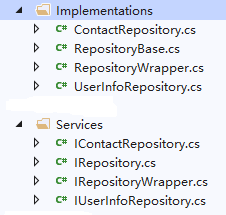基于EFcore 实现基本的数据库操作
0.代码关系与结构如图所示:
存在两个数据表,分别是UserInfo表、Contacts表,应用Scaffold-DbContext生成Model
创建两个文件夹,分别是Services(接口)、Implementation(接口的实现)


1.操作步骤:
a.创建IRepository接口;
b.创建RepositoryBase:IRepository 实现基本数据库操作
c.分别创建IUserInfoRepository、IContactRepository
d.分别创建UserInfoRepository、ContactRepository
e.创建IRepositoryWrapper
f.创建RepositoryWrapper : IRepositoryWrapper 用于实现依赖注入
g.依赖注入
h.构造函数注入与应用
2.创建IRepository接口:
using Microsoft.EntityFrameworkCore.Storage;
using System;
using System.Collections.Generic;
using System.Data;
using System.Linq;
using System.Linq.Expressions;
using System.Threading;
using System.Threading.Tasks;
namespace WebApplication24.Services
{
public interface IRepository<T>
{
Task<bool> Insert(T t);
Task<bool> Update(T t);
Task<bool> Delete(T t);
Task<IEnumerable<T>> GetAllAsync();
Task<IEnumerable<T>> GetByConditionAsync(Expression<Func<T, bool>> expression);
Task<T> GetByIdAsync(object id);
Task<bool> IsExistAsync(object id);
Task<int> GetCountAsync(T t);
Task<IDbContextTransaction> BeginTransactionAsync(IsolationLevel isolationLevel = IsolationLevel.Unspecified,CancellationToken cancellationToken = default);
}
}
3.创建RepositoryBase:IRepository 实现基本数据库操作
using Microsoft.EntityFrameworkCore;
using Microsoft.EntityFrameworkCore.ChangeTracking;
using Microsoft.EntityFrameworkCore.Metadata;
using Microsoft.EntityFrameworkCore.Storage;
using System;
using System.Collections.Generic;
using System.Data;
using System.Linq;
using System.Linq.Expressions;
using System.Threading;
using System.Threading.Tasks;
namespace WebApplication24.Services
{
public class RepositoryBase<T> : IRepository<T> where T : class
{
private readonly DbContext dbContext;
public RepositoryBase(DbContext dbContext) => this.dbContext = dbContext;
public async Task<bool> Insert(T entity)
{
bool bRet = false;
if (entity == null)
{
return bRet;
}
bRet = IsEntityValid(entity);
if (!bRet)
{
return bRet;
}
dbContext.Set<T>().Add(entity);
return await dbContext.SaveChangesAsync() > 0;
}
public async Task<bool> Update(T entity)
{
bool bRet = false;
if (entity == null)
{
return bRet;
}
bRet = IsEntityTracked(entity);
if (!bRet)
{
return bRet;
}
bRet = IsEntityValid(entity);
if (!bRet)
{
return bRet;
}
dbContext.Set<T>().Update(entity);
return await dbContext.SaveChangesAsync() > 0;
}
public async Task<bool> Delete(T entity)
{
bool bRet = false;
if (entity == null)
{
return bRet;
}
bRet = IsEntityTracked(entity);
if (!bRet)
{
return bRet;
}
bRet = IsEntityValid(entity);
if (!bRet)
{
return bRet;
}
dbContext.Set<T>().Remove(entity);
return await dbContext.SaveChangesAsync() > 0;
}
public Task<IEnumerable<T>> GetAllAsync()
{
return Task.FromResult(dbContext.Set<T>().AsEnumerable());
}
public Task<IEnumerable<T>> GetByConditionAsync(Expression<Func<T, bool>> expression)
{
return Task.FromResult(dbContext.Set<T>().Where(expression).AsEnumerable());
}
public async Task<T> GetByIdAsync(object id)
{
if (id == null)
{
return null;
}
return await dbContext.Set<T>().FindAsync(id);
}
public async Task<bool> IsExistAsync(object id)
{
if (id == null)
{
return false;
}
return await dbContext.Set<T>().FindAsync(id) != null;
}
public async Task<int> GetCountAsync(T entity)
{
return await dbContext.Set<T>().CountAsync();
}
public async Task<IDbContextTransaction> BeginTransactionAsync(IsolationLevel isolationLevel = System.Data.IsolationLevel.Unspecified, CancellationToken cancellationToken = default)
{
return await dbContext.Database.BeginTransactionAsync(isolationLevel, cancellationToken);
}
private bool IsEntityValid(T entity)
{
//判断entity是否是DbContext的Model
IEntityType entityType = dbContext.Model.FindEntityType(typeof(T));
if (entityType == null)
{
return false;
}
//获取主键值名称
string keyName = entityType.FindPrimaryKey().Properties.Select(p => p.Name).FirstOrDefault();
if (string.IsNullOrEmpty(keyName))
{
return false;
}
//获取主键类型
Type keyType = entityType.FindPrimaryKey().Properties.Select(p => p.ClrType).FirstOrDefault();
if (keyType == null)
{
return false;
}
//获取主键值类型的默认值
object keyDefaultValue = keyType.IsValueType ? Activator.CreateInstance(keyType) : null;
//获取当前主键值
object keyValue = entity.GetType().GetProperty(keyName).GetValue(entity, null);
if (keyDefaultValue.Equals(keyValue))
{
return false;
}
else
{
return true;
}
}
private bool IsEntityTracked(T entity)
{
EntityEntry<T> trackedEntity = dbContext.ChangeTracker.Entries<T>().FirstOrDefault(o => o.Entity == entity);
if (trackedEntity == null)
{
return false;
}
else
{
return true;
}
}
}
}
4.创建IUserInfoRepository、IContactRepository
using System;
using System.Collections.Generic;
using System.Linq;
using System.Threading.Tasks;
using WebApplication24.Models;
namespace WebApplication24.Services
{
public interface IUserInfoRepository : IRepository<UserInfo>
{
}
public interface IContactRepository : IRepository<Contact>
{
}
}
5.创建UserInfoRepository、ContactRepository
using Microsoft.EntityFrameworkCore;
using System;
using System.Collections.Generic;
using System.Linq;
using System.Threading.Tasks;
using WebApplication24.Models;
namespace WebApplication24.Services
{
public class UserInfoRepository : RepositoryBase<UserInfo>,IUserInfoRepository
{
public UserInfoRepository(DbContext dbContext):base(dbContext)
{
}
}
public class ContactRepository : RepositoryBase<Contact>,IContactRepository
{
public ContactRepository(DbContext dbContext):base(dbContext)
{
}
}
}
6.创建IRepositoryWrapper
using System;
using System.Collections.Generic;
using System.Linq;
using System.Threading.Tasks;
namespace WebApplication24.Services
{
public interface IRepositoryWrapper
{
IUserInfoRepository UserInfo{
get; }
IContactRepository Contact {
get; }
}
}
7.创建RepositoryWrapper
using System;
using System.Collections.Generic;
using System.Linq;
using System.Threading.Tasks;
using WebApplication24.Models;
namespace WebApplication24.Services
{
public class RepositoryWrapper : IRepositoryWrapper
{
private readonly ExampleContext _exampleContext;
public RepositoryWrapper(ExampleContext exampleContext) => _exampleContext = exampleContext;
public IUserInfoRepository UserInfo => new UserInfoRepository(_exampleContext);
public IContactRepository Contact => new ContactRepository(_exampleContext);
}
}
8.依赖注入 StartUp类
public void ConfigureServices(IServiceCollection services)
{
services.AddControllersWithViews();
services.AddDbContext<ExampleContext>(options => {
options.UseSqlServer(Configuration.GetConnectionString("defaultConnection"));
});
services.AddScoped<IRepositoryWrapper, RepositoryWrapper>();
}
9.构造注入
using Microsoft.AspNetCore.Mvc;
using Microsoft.EntityFrameworkCore.Storage;
using Microsoft.Extensions.Logging;
using System;
using System.Collections.Generic;
using System.Data;
using System.Diagnostics;
using System.Linq;
using System.Threading.Tasks;
using WebApplication24.Models;
using WebApplication24.Services;
namespace WebApplication24.Controllers
{
public class HomeController : Controller
{
private readonly ILogger<HomeController> _logger;
private readonly IRepositoryWrapper _db;
public HomeController(ILogger<HomeController> logger,IRepositoryWrapper repositoryWrapper)
{
_logger = logger;
_db = repositoryWrapper;
}
public async Task<IActionResult> Index()
{
IDbContextTransaction transaction = await _db.UserInfo.BeginTransactionAsync(IsolationLevel.ReadCommitted);
try
{
await _db.UserInfo.Delete(new UserInfo() {
Id = 4, Name = "Hanmeimei", Age = 30 });
await _db.Contact.Insert(new Contact() {
Id = 40, Name = "Hanmeimei", Phone = "13155556666", Address = "Beijing" });
await transaction.CommitAsync();
}
catch (Exception)
{
await transaction.RollbackAsync();
}
return View();
}
}
}
自学EFCore,具体源码在我的Space里可以下载,共勉喽
Happy Ending